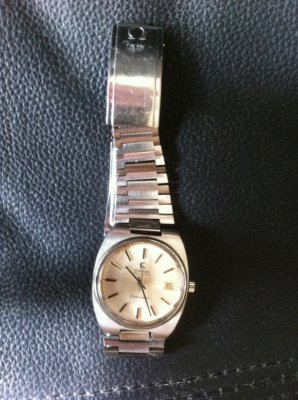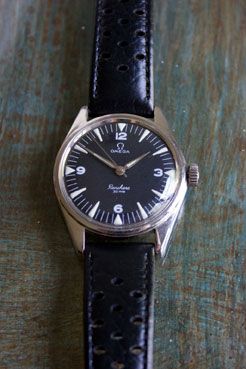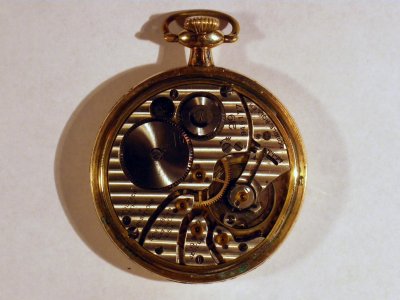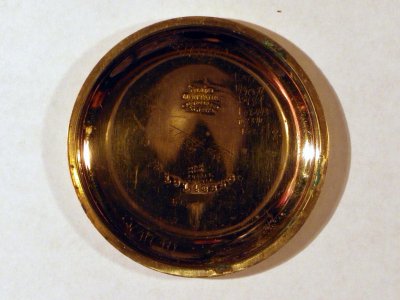Want to buy or sell something? Check the classifieds
-
The Fedora Lounge is supported in part by commission earning affiliate links sitewide. Please support us by using them. You may learn more here.
You are using an out of date browser. It may not display this or other websites correctly.
You should upgrade or use an alternative browser.
You should upgrade or use an alternative browser.
Let's See Your Watches! The Vintage Watch Thread.
- Thread starter Chamorro
- Start date
- Messages
- 54,308
My trusty Omega Sea Master that I found years ago on E-Bay. Haven't a clue as to age.
View attachment 2107
Looks like 70s but I would need a movement serial number to be sure. A Seamaster is always a nice watch.
- Messages
- 54,308
Glow in the dark hands and dial. I bet they still glow at night too.
Don Dahlberg
Familiar Face
- Messages
- 68
- Location
- Southcentral PA
You can date Omega watches by using the serial number and the chart at http://www.chronomaddox.com/omega_serial_numbers.html
This site will also tell you how to contact Omega for vintage watch information.
Don Dahlberg
NAWCC volunteer
This site will also tell you how to contact Omega for vintage watch information.
Don Dahlberg
NAWCC volunteer
Don Dahlberg
Familiar Face
- Messages
- 68
- Location
- Southcentral PA
"I believe this South Bend pocket watch belonged to one of my great-grandfathers. I never wear it, and it spends most of its time in a display case on my desk, though I often forget to wind it. It runs good, but I don't really know a thing about it, perhaps someone here might know something about these things."
Conelrad:
A picture of the movement and the serial number of the movement will allow us to comment on your South Bend.
Don Dahlberg
NAWCC volunteer
Conelrad:
A picture of the movement and the serial number of the movement will allow us to comment on your South Bend.
Don Dahlberg
NAWCC volunteer
These are the only watches I have used since I got out of the military back in '91. I quit wearing a wristwatch in boot camp, as I had no need to tell what time it was. After I got out of basic, one of the first things I was handed in tech school was a beeper with a clock display (so the training instructors could summon the student leader cadre without having to get up off their butts) I never went back to wearing a wristwatch, as I have had a pager, or later a cell phone, with a clock display on it practically surgically implanted by GE ever since. But I do occasionally carry one of these, either in a vest pocket or the watch pocket of my 501's (now that I work from home and don't have to dress for work)
This is my personal watch. it's a 1918 production Hamilton 992 railroad watch. I purchased it at the Houston NAWCC show many years ago, and added the graduated link, hallmarked sterling chain and US liberty gold piece. The watch features an enamel over brass triple sunk dial with the minutes marked in five minute intervals. The case is nickle steel as opposed to the more common gold filled (brass with a layer of gold mechanically bonded to each side, rather than electrically plated) cases on railroad watches, which tend to wear through the gold on the edges. The Hamilton 992 was the most successful railroad watch ever made, even if not the fanciest or most expensive. IMHO, it represents the pinnacle of mechanical watchmaking in America. 21 jewels, adjusted to 5 positions, it was accurate to less than 30 seconds variation per WEEK. The balance wheel was solid gold, with the rest of the geartrain crafted from several different alloys, depending on it's function. There were fancier watches, and much more expensive watches, but I know of none that do the job they were designed to do with the simplicity, affordability and elegance of the 992 movement.
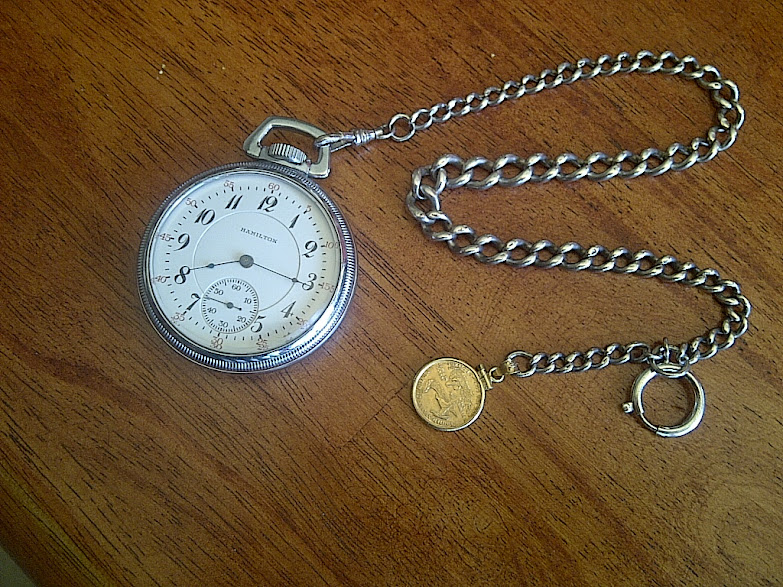

This is my Grandfathers last railroad watch. He was lead dispatcher for the Union Pacific railroad in their Palestine, TX depot until he retired in the mid 80's. This is a mid 50's production Hamilton 992b. It was built after the demand for pocket watches started to decline, and that, together with the constraints that had been imposed on watch production during WWII forced the elimination of the solid gold balance wheel and the enameled, hand painted dials, in favor of more utilitarian materials. However, the newer, less flashy models were a little more mechanically advanced, being adjusted for 7 positions, and featuring elinvar hairsprings and active thermal compensation. The 992b was the second and last railroad standard watch to sell over a half million units.


This is my personal watch. it's a 1918 production Hamilton 992 railroad watch. I purchased it at the Houston NAWCC show many years ago, and added the graduated link, hallmarked sterling chain and US liberty gold piece. The watch features an enamel over brass triple sunk dial with the minutes marked in five minute intervals. The case is nickle steel as opposed to the more common gold filled (brass with a layer of gold mechanically bonded to each side, rather than electrically plated) cases on railroad watches, which tend to wear through the gold on the edges. The Hamilton 992 was the most successful railroad watch ever made, even if not the fanciest or most expensive. IMHO, it represents the pinnacle of mechanical watchmaking in America. 21 jewels, adjusted to 5 positions, it was accurate to less than 30 seconds variation per WEEK. The balance wheel was solid gold, with the rest of the geartrain crafted from several different alloys, depending on it's function. There were fancier watches, and much more expensive watches, but I know of none that do the job they were designed to do with the simplicity, affordability and elegance of the 992 movement.
This is my Grandfathers last railroad watch. He was lead dispatcher for the Union Pacific railroad in their Palestine, TX depot until he retired in the mid 80's. This is a mid 50's production Hamilton 992b. It was built after the demand for pocket watches started to decline, and that, together with the constraints that had been imposed on watch production during WWII forced the elimination of the solid gold balance wheel and the enameled, hand painted dials, in favor of more utilitarian materials. However, the newer, less flashy models were a little more mechanically advanced, being adjusted for 7 positions, and featuring elinvar hairsprings and active thermal compensation. The 992b was the second and last railroad standard watch to sell over a half million units.
Last edited:
Featured products
-
 John Lofgren Monkey Boots Shinki Horsebuttt - $1,136 The classic monkey boot silhouette in an incredibly rich Shinki russet horse leather.
John Lofgren Monkey Boots Shinki Horsebuttt - $1,136 The classic monkey boot silhouette in an incredibly rich Shinki russet horse leather. -
 Grant Stone Diesel Boot Dark Olive Chromexcel - $395 Goodyear welted, Horween Chromexcel, classic good looks.
Grant Stone Diesel Boot Dark Olive Chromexcel - $395 Goodyear welted, Horween Chromexcel, classic good looks. -
 Schott 568 Vandals Jacket - $1,250 The classic Perfecto motorcycle jacket, in a very special limited-edition Schott double rider style.
Schott 568 Vandals Jacket - $1,250 The classic Perfecto motorcycle jacket, in a very special limited-edition Schott double rider style.
CONELRAD
One of the Regulars
- Messages
- 263
- Location
- The Metroplex
Shangas
I'll Lock Up
- Messages
- 6,116
- Location
- Melbourne, Australia
Case serial numbers are useless. We need the WATCH serial-number. On this watch, it is...
946177
946177
CONELRAD
One of the Regulars
- Messages
- 263
- Location
- The Metroplex
I figured that it wasn't of any use, I only posted it because I wasn't sure if the markings in that picture were as clear and discernible as they are on the picture of the movement, and I didn't know if it might have some importance.
- Messages
- 54,308
Produced in 1920. A 19 Jewel #219 movement, lever set, size 16. It is a nice watch and a good grade of watch. Far fewer of these were made than Elgins, Walthams and even Hamiltons.Here is the movement:
View attachment 2120
And here is the inside of the back:
View attachment 2121
the number on it is 19142356
- Messages
- 54,308
I also forgot to mention that the watch was well kept up over the years as all those numbers scratched into the caseback were the times it was taken to the watchmaker and serviced.
CONELRAD
One of the Regulars
- Messages
- 263
- Location
- The Metroplex
Produced in 1920. A 19 Jewel #219 movement, lever set, size 16. It is a nice watch and a good grade of watch. Far fewer of these were made than Elgins, Walthams and even Hamiltons.
Thank you for the information, I always liked the watch, but I never even knew whether or not it was any good. I might even have to start wearing it now.
- Messages
- 54,308
Thank you for the information, I always liked the watch, but I never even knew whether or not it was any good. I might even have to start wearing it now.
By all means wear it and enjoy it.
DamianM
Vendor
- Messages
- 2,055
- Location
- Los Angeles
Here is a rose gold Benrus that I received as a gift for my birthday this year. From what I understand, it was made around 1950.
View attachment 2105
This is a 1948 Hamilton "Cld." Nordon that was my grandfather's high school graduation present. It sat in a drawer for years not running, until I finally had it restored, and just got it back from the watchmakers today.
View attachment 2106
I believe this South Bend pocket watch belonged to one of my great-grandfathers. I never wear it, and it spends most of its time in a display case on my desk, though I often forget to wind it. It runs good, but I don't really know a thing about it, perhaps someone here might know something about these things.
View attachment 2104
the benrus does not look early 50s
it must be 30s judging by the total "art deconess" of the watch.
CONELRAD
One of the Regulars
- Messages
- 263
- Location
- The Metroplex
the benrus does not look early 50s
it must be 30s judging by the total "art deconess" of the watch.
I thought the same, but I did some research on the Benrus BB3 movement, and the little I found pointed towards 1950. From what I understand, the BB3 was a Benrus branded ETA 900 movement.
Of course, my research was far from thorough, and I don't know much about watches in general, so I can't speak too much of the accuracy of that date. I also have no idea about the history of the watch.
Last edited:
Don Dahlberg
Familiar Face
- Messages
- 68
- Location
- Southcentral PA
Jskeen,
I have some corrections to point out about your Hamilton watches.
The 992 went to the Finishing Department of Hamilton on September 10, 1921. It probably took a month or two to make it out of the Finishing Department and to be sold to the wholesaler. So you watch was sold in late 1921. The Hamilton 992 was the most popular railroad watch ever.
The 992B is a better watch in terms of function for reasons I shall explain later, but it is not as nice in pure beauty as the 992 (IMHO). We do not have good records for watches this late, but it should date in the late 50s. Before 1921 most watches were not cased at the factory. You went into a jeweler and chose a movement and chose a case and they were joined. Hamilton started casing many watches in the mid 1920s and your case is one of the two most popular "bar over crown" railroad grade watch cases. It is the Hamilton number 17 railroad case. The bar was to prevent the accidental pulling of the stem. This case was introduced in 1956, so that puts a floor on your watch date.
The correction that I have to make is that the balance is NOT solid gold in either watch. That would not work very well. The main problem with keeping good time is that when the temperature got warm, the hairspring on the balance would weaken and the watch would slow down. Common watches before the 1850s kept time to only 5 to 10 minutes per day. The compensated balance was created where they made the ring of the balance with steel on the inside and brass on the outside of the ring. Look at your 992 under magnification and you will see the outer ring of the balance is two colors. The ring of the balance is also split near each arm. As the temperature get hot the brass expands more than the steel, bending the ring inward. Like a spinning ice skater bringing her arms in, increases the rate of rotation. So this effect would cancel the weakening hairspring so that a change in temperature would only effect the rate of the watch within about 5 seconds per day. To make this work, the screws on the balance had to be placed (adjusted) to get the right cancelling effect. Not too much and not too little. They adjusted the screws to keep good time near freezing and near 90 F. That resulted in a middle temperature error of only about 5 seconds per day. This adjustment was done by trial and error and took many days. That was part of the cost. The balance was also poised or balanced using the screws just like you balance a tire on your car. This prevented positional errors. By the way, the screws on the balance of a 992 are gold, and that is what you may have confused. Less expensive watches used brass screws.
In the 992E in the early 1930s they started making hairsprings out of an alloy call Elinvar, which was named for the fact that it did not weaken with heat. This meant they no longer needed a compensated balance. The balance was then made out of Invar that did not expand with heat. Elinvar had other problems. It would lose its shape very easily, so Hamilton modified the alloy to correct for these problems. They came up with Einvar Extra, the best hairspring made until very recently. This was introduced in the 992B about 1940. This hairspring had all the best features of the old steel hairsprings and and yet had no temperature problems. This is why the 992B is the best performing railroad grade watch ever.
One more thing that makes your 992B special is that is has a Montgomery dial. This was a special patented dial that featured the individual minutes numbered and the "6" in the seconds chapter. Hamilton had to pay a royalty to Montgomery to use this dial and so it cost extra to the customer. Collectors love that. So your 992B is the more collectable watch. However, I still love the 992 the most.
I would carry the 992 and enjoy it. Have it properly cleaned at least every 3 to 5 years. These cases are not dust proof and dust is an abrasive. I would take special care of the 992B because of the special case and dial and because it is a 992B.
Don Dahlberg
NAWCC Library and Research Center volunteer
I have some corrections to point out about your Hamilton watches.
The 992 went to the Finishing Department of Hamilton on September 10, 1921. It probably took a month or two to make it out of the Finishing Department and to be sold to the wholesaler. So you watch was sold in late 1921. The Hamilton 992 was the most popular railroad watch ever.
The 992B is a better watch in terms of function for reasons I shall explain later, but it is not as nice in pure beauty as the 992 (IMHO). We do not have good records for watches this late, but it should date in the late 50s. Before 1921 most watches were not cased at the factory. You went into a jeweler and chose a movement and chose a case and they were joined. Hamilton started casing many watches in the mid 1920s and your case is one of the two most popular "bar over crown" railroad grade watch cases. It is the Hamilton number 17 railroad case. The bar was to prevent the accidental pulling of the stem. This case was introduced in 1956, so that puts a floor on your watch date.
The correction that I have to make is that the balance is NOT solid gold in either watch. That would not work very well. The main problem with keeping good time is that when the temperature got warm, the hairspring on the balance would weaken and the watch would slow down. Common watches before the 1850s kept time to only 5 to 10 minutes per day. The compensated balance was created where they made the ring of the balance with steel on the inside and brass on the outside of the ring. Look at your 992 under magnification and you will see the outer ring of the balance is two colors. The ring of the balance is also split near each arm. As the temperature get hot the brass expands more than the steel, bending the ring inward. Like a spinning ice skater bringing her arms in, increases the rate of rotation. So this effect would cancel the weakening hairspring so that a change in temperature would only effect the rate of the watch within about 5 seconds per day. To make this work, the screws on the balance had to be placed (adjusted) to get the right cancelling effect. Not too much and not too little. They adjusted the screws to keep good time near freezing and near 90 F. That resulted in a middle temperature error of only about 5 seconds per day. This adjustment was done by trial and error and took many days. That was part of the cost. The balance was also poised or balanced using the screws just like you balance a tire on your car. This prevented positional errors. By the way, the screws on the balance of a 992 are gold, and that is what you may have confused. Less expensive watches used brass screws.
In the 992E in the early 1930s they started making hairsprings out of an alloy call Elinvar, which was named for the fact that it did not weaken with heat. This meant they no longer needed a compensated balance. The balance was then made out of Invar that did not expand with heat. Elinvar had other problems. It would lose its shape very easily, so Hamilton modified the alloy to correct for these problems. They came up with Einvar Extra, the best hairspring made until very recently. This was introduced in the 992B about 1940. This hairspring had all the best features of the old steel hairsprings and and yet had no temperature problems. This is why the 992B is the best performing railroad grade watch ever.
One more thing that makes your 992B special is that is has a Montgomery dial. This was a special patented dial that featured the individual minutes numbered and the "6" in the seconds chapter. Hamilton had to pay a royalty to Montgomery to use this dial and so it cost extra to the customer. Collectors love that. So your 992B is the more collectable watch. However, I still love the 992 the most.
I would carry the 992 and enjoy it. Have it properly cleaned at least every 3 to 5 years. These cases are not dust proof and dust is an abrasive. I would take special care of the 992B because of the special case and dial and because it is a 992B.
Don Dahlberg
NAWCC Library and Research Center volunteer
Talbot
One Too Many
- Messages
- 1,855
- Location
- Melbourne Australia
Don,
Always a pleasure to read your informative posts.
Many thanks,
Talbot
Always a pleasure to read your informative posts.
Many thanks,
Talbot
Jskeen,
The 992 went to the Finishing Department of Hamilton on September 10, 1921. It probably took a month or two to make it out of the Finishing Department and to be sold to the wholesaler. So you watch was sold in late 1921. The Hamilton 992 was the most popular railroad watch ever.
Thanks, all this time I have just been going by the movement serial number date table
The 992B is a better watch in terms of function for reasons I shall explain later, but it is not as nice in pure beauty as the 992 (IMHO). We do not have good records for watches this late, but it should date in the late 50s. Before 1921 most watches were not cased at the factory. You went into a jeweler and chose a movement and chose a case and they were joined. Hamilton started casing many watches in the mid 1920s and your case is one of the two most popular "bar over crown" railroad grade watch cases. It is the Hamilton number 17 railroad case. The bar was to prevent the accidental pulling of the stem. This case was introduced in 1956, so that puts a floor on your watch date.
The correction that I have to make is that the balance is NOT solid gold in either watch. That would not work very well.
You are of course correct. I was recalling the screws, not the entire wheel (Nor the center wheel, Henry Fried notwithstanding)
One more thing that makes your 992B special is that is has a Montgomery dial. This was a special patented dial that featured the individual minutes numbered and the "6" in the seconds chapter. Hamilton had to pay a royalty to Montgomery to use this dial and so it cost extra to the customer. Collectors love that. So your 992B is the more collectable watch. However, I still love the 992 the most.
I also prefer the Montgomery dial, (As much as I like Webb C. Ball's modifications of the Hamilton movements, I never understood his opposition to the Montgomery dial). However I was told that the 992b dial had been changed to either celluloid or some other material rather than the 3 piece enameled brass as a cost cutting measure. If that is not necessarily the case, I may need to open Pop's up to verify.
I would carry the 992 and enjoy it. Have it properly cleaned at least every 3 to 5 years. These cases are not dust proof and dust is an abrasive. I would take special care of the 992B because of the special case and dial and because it is a 992B.
I carry the 992 because I prefer it on aesthetic grounds, and also because should it be damaged, I would be bummed, but it could be replaced, whereas if I was in a car wreck or some other catastrophe and damaged Grandpa's watch, it would be irreplaceable, and my Mom and my Eldest Son would both probably shun me. I still take it to the same watch shop in Palestine where he had it serviced and still receive my copy of the three part form and the vibrograph chart every other year. Although the gentleman who does it tells me every time that he may not be around next time, but if he's breathing, he'll be happy to work on "Hoyt's watch" again.
Don Dahlberg
NAWCC Library and Research Center volunteer
Thanks for the info!
Similar threads
- Replies
- 17
- Views
- 5K
- Replies
- 25
- Views
- 8K
